Click on images to enlarge
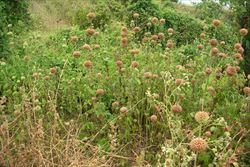
infestation of mature plants in fruit (Photo: Forest and Kim Starr)
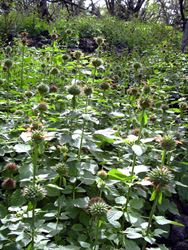
infestation of flowering plants (Photo: Forest and Kim Starr)
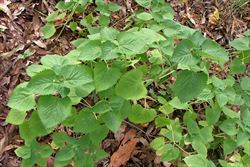
habit of young plants (Photo: Sheldon Navie)

habit in flower and fruit (Photo: Sheldon Navie)

leaves and grooved four-angled stem (Photo: Sheldon Navie)
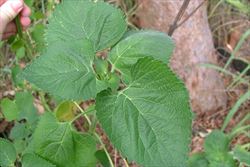
lower leaves (Photo: Sheldon Navie)

upper leaves and flower clusters (Photo: Sheldon Navie)
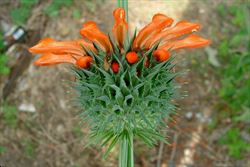
flower cluster (Photo: Sheldon Navie)

close-up of flowers (Photo: Sheldon Navie)
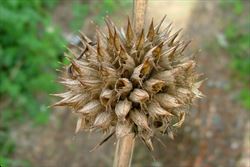
mature fruit (Photo: Sheldon Navie)
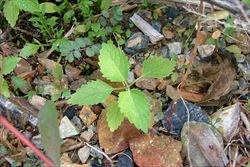
seedling (Photo: Sheldon Navie)
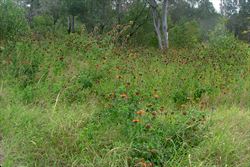
large infestation in an open woodland at Riverveiw in Ipswich (Photo: Sheldon Navie)
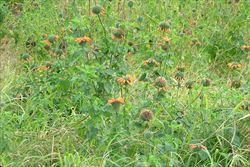
habit in flower and fruit (Photo: Sheldon Navie)
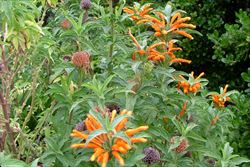
the similar lion's ear (Leonotis leonurus), with relatively narrow leaves (Photo: Sheldon Navie)
Scientific Name
Leonotis nepetifolia (L.) W.T. Ait.
Synonyms
Leonotis nepetaefolia (L.) R. Br.Phlomis nepetaefolia L.
Family
Labiatae (South Australia)Lamiaceae (Queensland, New South Wales, the ACT, Victoria, Tasmania, Western Australia and the Northern Territory)
Common Names
bald head, bird honey, Christmas candlestick, Johnny Collins, lion's ear, lion's tail
Origin
Native to tropical and sub-tropical Africa, but now a widespread weed of the tropical regions of the world (i.e. pan-tropical).
Cultivation
Lion's tail (Leonotis nepetifolia) has been widely cultivated as a garden ornamental.
Naturalised Distribution
Widely naturalised in northern Australia (i.e. naturalised in northern and central Queensland, in the north-western parts of the Northern Territory, and in northern Western Australia). Also occasionally recorded from south-eastern Queensland and near Perth south-western Western Australia.
Habitat
This species is mostly found in tropical regions, but also grows in sub-tropical and warmer temperate areas. It is a weed of roadsides, overgrazed pastures, disturbed sites, waste areas, waterways and floodplains.
Habit
An upright (i.e. erect), slender, short-lived (i.e. annual) herb usually growing 1-2 m tall, but occasionally reaching up to 3 m in height.
Distinguishing Features
- an upright and sparsely branched large herbaceous plant usually growing 1-2 m tall.
- its four-angled stems usually have a distinct groove running lengthwise down the centre of each side.
- its oppositely arranged leaves and relatively broad with distinctly toothed margins.
- its flowers are arranged in dense rounded clusters (5-6 cm across) in the upper leaf forks.
- each of the tubular orange flowers (about 20 mm long) is surrounded by a persistent green structure made up of the fused sepals.
Stems and Leaves
The stems are relatively robust, sparsely branched, and sparsely covered in small whitish hairs (i.e. they are puberulent). These stems are four-angled (i.e. quadrangular) and usually have a distinct groove running lengthwise (i.e. longitudinally) down the centre of each side.
The leaves (4.5-20 cm long and 2-15 cm wide) are oppositely arranged along the stems and borne on stalks (i.e. petioles) 2-10 mm long. The lower leaves, which are somewhat egg-shaped in outline (i.e. oblong-ovate or ovate), are larger and broader than those towards the top of the plant. All leaves have distinctly toothed (i.e. crenate or serrate) margins, pointed tips (i.e. acute apices), and are sparsely hairy (i.e puberulent).
Flowers and Fruit
The flowers are borne in dense rounded (i.e. spherical) clusters (5-6 cm across) towards the tops of the stems (usually 2-4 clusters per stem). Each of these clusters is arranged directly on the main stem, just above a pair of leaves (i.e. sessile axillary clusters). The individual flowers (20-40 mm long) are orange or reddish-orange in colour and tubular in shape with two main lobes (i.e. they are two-lipped). The lower of these lobes is further divided near its tip, while the upper lobe is somewhat arched or curved and densely hairy. These flowers are surrounded by a green tube (i.e. calyx tube) 12-15 mm long and each flower also has two elongated (i.e. lanceolate) and pointed green bracts associated with it. Flowering occurs mostly from summer through to early winter (i.e. from December to July).
The flower clusters form a hard and somewhat spiky ball when mature, and consist mainly of the persistent calyx tubes (which enlarge to 15-25 mm long in fruit). Each individual fruit is a four-lobed 'capsule' (i.e. schizocarp) that separates into four 'seeds' (i.e. nutlets) when mature. These 'seeds' are dark brown or dull black in colour, and either somewhat egg-shaped (i.e. oblong-ovoid) or triangular in shape (2.5-4.3 mm long and 1-1.9 mm wide).
Reproduction and Dispersal
This species reproduces entirely by seed. The seeds are dispersed by water and in mud adhering to animals, machinery and other vehicles.
Environmental Impact
Lion's tail (Leonotis nepetifolia) is regarded as an environmental weed in the Northern Territory, Queensland and Western Australia. During a recent survey, it was also listed as a priority environmental weed in two Natural Resource Management regions. This species has the ability to form large colonies that displace native species, particularly along riverbanks and on floodplains in the wet-dry tropics regions of northern Australia. While already widespread, lion's tail (Leonotis nepetifolia) has the potential to increase its distribution and abundance and become a more serious weed in these areas in the future.
It is currently most widespread and troublesome in the Northern Territory, where it is a significant weed in the Darwin, Victoria River, Daly River and Gulf Coastal regions, and an emerging threat in the VRD-Sturt bioregion. Lion's tail (Leonotis nepetifolia) is also relatively common in northern Queensland's Gulf Country and on Cape York Peninsula. It is causing major problems in some of the riparian areas located in Lawn Hill National Park, in north-western Queensland. It is also listed as a high priority pest plant in Townsville City and a medium priority pest plant in the Mackay-Whitsunday region. In recent years, it has also become more common in central and south-eastern Queensland.
In Western Australia, where lion's tail (Leonotis nepetifolia) is a more recent introduction, it is an occasional weed of disturbed sites and savannah vegetation near creeklines in the Kimberley region. It has also been recorded as a garden escape in Kings Park in Perth, and was ranked as a moderate priority environmental weed in the Environmental Weed Strategy of Western Australia.
Other Impacts
Lion's tail (Leonotis nepetifolia) is also a problem species for cattle producers in northern Australia. It displaces more useful pasture species, particularly in over-grazed pastures, and reduces the productivity of infested areas. Dense infestations along riverbanks and on floodplains also reduce the accessibility of waterways to livestock, due to the spiky nature of the seed-heads.
Legislation
This species is declared under legislation in the following states and territories:
- Northern Territory: B - growth and spread of this species to be controlled (throughout all of the Territory), and C - not to be introduced into the Territory.
- Western Australia: Unassessed - this species is declared in other states or territories and is prohibited until assessed via a weed risk assessment (throughout the entire state).
Management
For information on the management of this species see the following resources:
- the Northern Territory Department of Natural Resources, Environment and The Arts Agnote on this species, which is available online at http://www.nt.gov.au/weeds.
Similar Species
Lion's tail (Leonotis nepetifolia) is very similar to lion's ear (Leonotis leonurus) and relatively similar to knobweed (Hyptis capitata) and hyptis (Hyptis suaveolens). These species can be distinguished by the following differences:
- lion's tail (Leonotis nepetifolia) has relatively broad lower leaves (4.5-20 cm long and 2-15 cm wide). Its orange flowers (about 20 mm long) are borne in relatively large globular clusters (50-60 mm across) directly on the upper stems (i.e. in sessile axillary clusters).
- lion's ear (Leonotis leonurus) has relatively narrow lower leaves (5-8 cm long and 1-1.5 cm wide). Its orange flowers (30-55 mm long) are borne in very large globular clusters (up to 100 mm across) directly on the upper stems (i.e. in sessile axillary clusters).
- knobweed (Hyptis capitata) has relatively broad lower leaves (5-15 cm long and 2-6 cm wide). Its small white flowers (5-6 mm long) are borne in small globular clusters (15 mm across) on stalks up to 5 cm long (i.e. in pedunculate axillary clusters).
- hyptis (Hyptis suaveolens) has relatively broad lower leaves (2-10 cm long and 1-7 cm wide). Its small pinkish, bluish-purple, or lavender flowers (5-7 mm long) are borne in few-flowered clusters in the leaf forks (i.e. in pedunculate axillary clusters).

